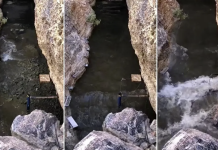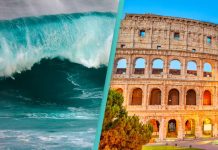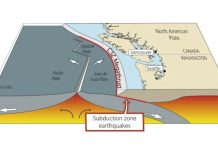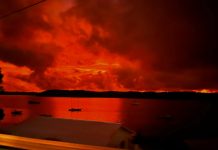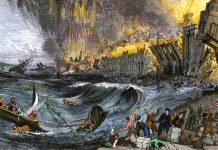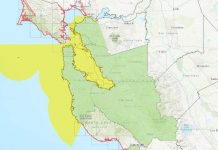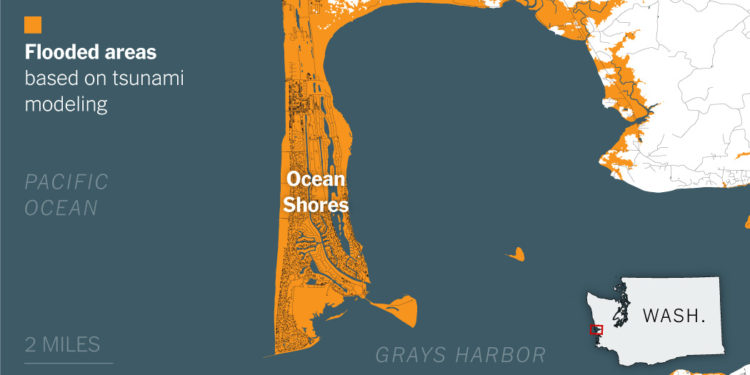
The 350 children at Ocean Shores Elementary School have practiced their earthquake survival plans, dropping under desks to ride out the convulsions, then racing upstairs to the second floor to await the coming tsunami.
Unless something changes, their preparations will most likely be futile.
The Cascadia fault off the Pacific Northwest coast is poised for a massive, 9.0-magnitude earthquake at some point, scientists say, a rupture that would propel a wall of water across much of the Northwest coast within minutes. Low-lying coastal neighborhoods in Washington, Oregon and Northern California would be under 10 feet or more of water, with the elementary school in Ocean Shores, Wash., facing an inundation that could be 23 feet deep.
The second-floor refuge students rush to in their drills stands 13 feet off the ground — in a structure that was not built to withstand a raging tsunami in the first place.
“The fact of the matter is that if a tsunami occurs tomorrow, we are going to lose all of our children,” said Andrew Kelly, the superintendent of the North Beach School District, which includes Ocean Shores. Mr. Kelly is one of a growing number of local officials who are calling for a network of elevated buildings and platforms along the Northwest coast that could provide an escape for thousands of people who might otherwise be doomed in the event of a tsunami.
On Tuesday, voters in Ocean Shores and neighboring communities will decide whether to approve a bond measure that would, in part, build new vertical additions at two schools, offering students and nearby residents a place to flee from a surging ocean.
Scientists have been warning for years that another catastrophic quake could erupt at any time in the Cascadia subduction zone, a 600-mile-long “megathrust” fault that stretches from Vancouver Island, British Columbia, to Cape Mendocino, Calif.
A quake from the fault, located roughly 70 miles offshore, could cause land along the shore to immediately drop by several feet. The sudden movement under the sea would send massive waves toward shore. And while recent tsunamis caused by earthquakes and volcanoes in the Pacific Rim have resulted in small surges on the West Coast of the United States hours later, a Cascadia wave would arrive at shorelines within 15 minutes.
Along many stretches of the Northwest coast, there are no bluffs or high buildings to climb — nowhere to go.
The lack of evacuation options means that the death toll could be almost unfathomable, far surpassing any other natural disaster in U.S. history. In Washington State, according to a 9.0 scenario the state uses for its estimates, about 70,000 people would likely be within the lowlands that could be engulfed by a large tsunami, and 32,000 of them would have no nearby high ground to escape to within 15 minutes.
Depending on the season and the time of day, Oregon estimates that 5,000 to 20,000 could die along the coast in a similar event, largely because of a lack of escape options; the state has planned for an even deadlier quake, based on the geological record, that could create a tsunami 100 feet high in some places. Additional deaths are expected in Northern California, notably in Crescent City, where a tsunami that came all the way from Alaska killed 11 people in 1962.
The question, scientists say, is not if but when. The chance of a 9.0 megaquake on the Cascadia fault in the next 50 years, according to the research, is about one in nine (although the chance of the precise kind of quake envisioned in the planning models used by each state would be less); the odds of a smaller but still powerful earthquake — of a magnitude greater than 7.0 — are one in three. Pressure is continuing to build along the hundreds of miles where the Juan de Fuca plate is pushing under the North American plate.
“Every day, on average, they are being pushed together at about the rate fingernails grow,” said Corina Allen, the chief hazards geologist in Washington State. “Every year that the earthquake doesn’t happen, there’s a higher chance that it will the next year.”
Officials over the years have posted signs for evacuation routes and plotted ways to move people to higher ground. But many communities remain painfully vulnerable.
In the Long Beach area of Washington, for example, several communities — home to thousands — lie along a flat, narrow peninsula that stretches more than 20 miles. Officials in recent years had considered building an artificial hill to help with tsunami evacuation but abandoned the idea when modeling showed it needed to be much higher than was feasible.
Perhaps nowhere is more vulnerable than Ocean Shores, an idyllic community of 6,700 residents, with thousands more who visit in the summer to escape urban life and enjoy the miles of pristine beach next to thundering waves. The town has little elevation, and the tsunami that could accompany a 9.0 rupture would wash over all of it.
People could try driving out, but officials expect roads to be buckled and sunken, or covered in power lines, trees and debris. The expected subduction would cause the entire area to abruptly sink up to seven feet; the shaking could cause liquefaction of sandy soils before the tsunami reached shore.
People could try running to high ground outside of town, but Ocean Shores sits on a six-mile-long peninsula. Those who live toward the southern end would be about eight miles away from high ground. Depending on their location, residents might have only 10 minutes after the shaking stopped before the wave started washing over them.
“In 10 minutes, there’s not that much time to go very far,” Ms. Allen said.
The best option may be to get on a rooftop or to climb a tree. But many of the region’s buildings were not constructed to withstand such a quake, let alone a tsunami, which would be hurtling cars and logs and other debris at objects in its path.
Dozens of other waterfront communities are also at risk, researchers said, including Seaside, Gearhart and Tillamook, in Oregon; Crescent City and the Samoa Peninsula, near Eureka, in California; and areas up and down the Washington coast.
To improve the chances of survival, officials in Washington State have proposed a network of 58 vertical evacuation structures along the outer coast and advised considering dozens of others. They could provide 22,000 people with an option for escape, although thousands of others would remain out of range.
Each structure could cost about $3 million.
Vertical evacuation structures have been embraced in Japan for years, in the form of platforms, towers and artificial berms. They became a refuge for many in the 2011 earthquake and tsunami, although that event still killed more than 19,000 people.
In the Pacific Northwest, only two vertical evacuation structures have been built so far. One is an Oregon State University building in Newport, Ore. The other is a portion of Ocosta Elementary School in Washington. Other cities have considered but not yet built evacuation towers, including Seaside, Ore., which relocated its middle school and high school to hills east of town.
In Tokeland, Wash., Charlene Nelson, the chairwoman of the Shoalwater Bay Tribe, said the tribe has been working for about 18 years on escape strategies. Their first recourse was a building up in the hills designed as an evacuation center, with supplies.
They ran practice events to get people to high ground, but one of the many families living on the narrow strip of land jutting into Willapa Bay found it took them 56 minutes by foot to get up to the center. The wave would most likely arrive in 20 minutes.
The tribe recently broke ground on a tower, largely funded by the Federal Emergency Management Agency, with pilings buried 51 feet in the ground and two elevated platforms that could hold hundreds of people.
Even when the structure is completed, Ms. Nelson said, people will need to practice their escape plans and know the routes to possible safety. They need a bag ready to go with key supplies — but not so many that it will slow them down when running for their lives. There won’t be time for hesitation or for figuring out which direction to head.
“You need to be prepared, and you need to know what to do, and you need to do it,” she said.
Aside from whatever damage a tsunami might bring, the earthquake itself would bring widespread devastation, with crumbling buildings, failing bridges, energy disruptions and mass casualties across a 140,000-square-mile area, including Seattle and Portland.
The urgency has been building over the past few years, which in coastal towns have felt like a ticking clock.
The last large quake on the Cascadia fault occurred on Jan. 26, 1700, scientists say. Chris Goldfinger, a researcher at Oregon State University, said geologic evidence from the past 10,000 years indicates that massive quakes with a magnitude of around 9.0 happen on the fault on an average of every 430 years. When including smaller but still powerful quakes on portions of the fault, the timeline in some areas shrinks to every 250 years.
It has been 322 years.
Bringing the expected casualty numbers down is difficult when the response planning has largely been left up to each community, Mr. Goldfinger said. A comprehensive federal solution with accompanying funding is needed, he said, and there is little time for delay given the amount of work needed to prepare.
“It’s going to dwarf the scale of any disaster we have ever had,” Mr. Goldfinger said. “We know it’s coming.”
The post The Tsunami Could Kill Thousands. Can They Build An Escape? appeared first on New York Times.
Subscribe to Galileyo
Galileyo is a new Information Distribution Platform that gathers uncensored information from our proprietary global information sources and delivers that information to you, regardless of the situation on the ground, via global Satellite Phone Networks.
Subscribe to Galileyo
Support my work
If you follow my website StrangeSounds.org, you already know that my site has been banned from ALL ADS NETWORKS! So now I really count on you and your donations to keep Strange Sounds up and running! Support my work and family. Thank you for your help!
Paypal Donation Link
If you use Amazon, you can also use our link below, to enable us getting a small affiliate revenue. Thanks again!
Support Us With Amazon
Or if you enjoy natural health products, I recommend Natural Health Source:
Support Us With Natural Health Source
Finally, you can also subscribe to this blog to get more amazing news curated just for you right in your inbox on a daily basis.
Subscribe to my Newsletter
You should really subscribe to QFiles. You will get very interesting information about strange events around the world.




